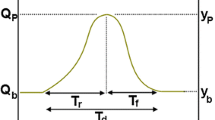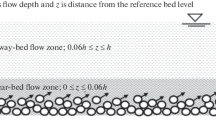Abstract
As one of the most important components of river mechanics, sediment transport capacity of sediment-laden flows has attracted much attention from many researchers working on river mechanics and hydraulic engineering. Based on the time-averaged equation for a turbulent energy equilibrium in solid and liquid two-phase flow, an expression for the efficiency coefficient of suspended load movement was derived for the two-dimensional, steady, uniform, fully-developed turbulent flow. A new structural expression of sediment transport capacity was achieved. Using 115 runs of flume experimental data, which were obtained through two kinds of sediment transport experiments in the state of equilibrium, in combination with the basic rheological and sediment transporting characteristics of hyperconcentrated flow, the main parameters in the structural expression of sediment transport capacity were calibrated, and a new formula of sediment transport capacity for hyperconcentrated flow was developed. A large amount of field data from the Yellow River, Wuding River, and Yangtze River, etc. were adopted to verify the new formula and good agreement was obtained. These results above contribute to an improved theoretical system of river mechanics and a reliable tool for management of rivers carrying high concentration of sediments.
Similar content being viewed by others
References
Gilbert G K. The transportation of debris by running water. US Geol Sur Prof Paper, 1914, 86: 59
Wang G Q. Advances in river sediment research. J Sed Res (in Chinese), 2007, (2): 64–81
Shu A P. Study on the sediment transport capacity and mechanism of hyperconcentrated flow (in Chinese). Dissertation for the Doctoral Degree. Beijing: Tsinghu University, 1994. 22–100
Einstein H A. The bed-load function for sediment transportation in open channel flows. Tech Bull, U.S. Dept of Agriculture, Soil Conservation Service, 1950, 1026: 7
Einstein H A, Chien N. Transport of sediment mixture with large range of grain sizes. In: M.R.D. Sediment Series No.2, Missouri River Div. Omaha: U.S. Corp. of Eng, 1955. 49
Velikanov M A. Alluvial Process. Moscow: State Publishing House for Physical and Mathematical Literature, 1958. 241–245
Researching Group of Wuhan University of Hydraulic Engineering. Study on sediment transport capacity in the middle and down steam of Yangtze River. J Sed Res (in Chinese), 1959, 2: 54–73
Yang C T. Incipient motion and sediment transport. J Hydraul Eng, ASCE, 1973, 99(10): 1679–1704
Yang C T. Minimum unit stream power and fluvial hydraulics. J Hydraul Div, 1976, 102: 769–784
Yang C T, Molinos A. Sediment transport and unit stream power function. J Hydraul Div, ASCE, 1982, 108(6): 774–793
Yang C T. Sediment transport and river engineering. In: Proc of 3rd Inter. River Sedimenttation. Mississippi: University of Mississippi, 1987
Cao R X. Mathematical model for sediment transport capacity in the intake channel of hyperconcentrated flow. J Hydraul Eng (in Chinese), 1987(9): 39–46
Zhang H W, Zhang Q. The calculating formulae of sediment transport capacity in Yellow River. People’s Yellow River (in Chinese), 1993, (11): 7–9
Fei X, Shu A. Investigation on sediment transport capacity with high concentration for fluvial river. J Hydraul Eng (in Chinese), 1998, (11): 38–43
Liu X N, Zhang Z, Cao S Y, et al. Study on the sediment transport capacity. J Sed Res (in Chinese), 2000, (4): 35–39
Dou G R, Dong F W. Carrying capacity of water wave and tidal current. Chin Sci Bull (in Chinese), 1995, 40(5): 443–446
Liu F, Li Y T. A new formula of sediment transport capacity in water flow. Journal of Yangtze River Scientific Research Institute (in Chinese), 1997, (3): 17–20
Yu M H, Yang G L, Liu G F, et al. A preliminary study on the formula of non-uniform sediment carrying capacity. J Sed Res (in Chinese), 2001, (3): 25–29
Guo Q C. Sediment-carrying capacity in natural rivers. J Sed Res (in Chinese), 2006, (5): 45–51
Wang Y L. Discuss on sediment transport capacity for various stages in the lower of Yangtze River. People’s Yangtze River (in Chinese), 2006, 37(12): 51–53
Cellino M, Graf W H. Sediment-laden flows in open-channels under non-capacity and capacity conditions. J Hydraul Eng, ASCE, 1999, 125(5): 455–462
Huang C, Wells L K, Norton L D. Sediment transport capacity and erosion processes: Model concepts and reality. Earth Sur Proc Landf, 1999, 24(6): 503–516
Song Z Y, Zhang W S, Kong J, et al. Optimum approach to determine the coefficients in sediment-carrying capacity formula. In: Proc of the 9th Inter. Symposium on River Sedimentation. Beijing: Tsinghua University Press, 2004. 1462–1466
Milhous R T. Climate change and changes in sediment transport capacity in the Colorado Plateau. USA, Sediment Budgets, 2005, 2(292): 271–278
Yang S Q. Sediment transport capacity in rivers. J Hydraul Res, 2005, 43(2): 131–138
Yang S Q, Koh S C, Kim I S, et al. Sediment transport capacity—An improved Bagnold formula. Int J Sed Res, 2007, 22(1): 27–38
Dieter R. Hyperconcentrated flow and sediment transport at steep slopes. J Hydraul Eng, ASCE, 1991, 117(11): 1419–1439
Xu J X. Response of river channel patterns to spatially varying suspended sediment concentration and some thresholds. Sci China Ser D-Earth Sci (in Chinese), 1997, 27(6): 548–553
Xu J X. Erosion caused by hyperconcentrated flow on the Loess Plateau of China. Catena, 1999, (36): 1–19
Xu J X. Grain-size characteristics of suspended sediment in the Yellow River, China. Catena, 1999, (38): 243–263
Guo J. Logarithmic matching and its application in computational hydraulics and sediment transport. J Hydraul Res IAHR, 2002, 40(5): 555–566
Cao Z X, Pender G, Carling P. Shallow water hydrodynamic models for hyperconcentrated sediment-laden floods over erodible bed. Adv Water Resour, 2006(29): 546–557
Shu A P. Verification and evaluation on river sediment carrying capacity formulae. People’s Yellow River (in Chinese), 1993(1): 7–9
Cao W H, Shu A P. Review for sediment transport capacity of suspended load at the action of tidal current and wave. J Sed Res (in Chinese), 1999, (5): 74–80
Chen X F, Chen L, Li Y T. Contrast of formulae of sediment carrying capacity for sediment-laden flow with high, median and low concentrations. J Wuhan Univ Hydraul Electr Eng (in Chinese), 1999, 32(5): 1–5
Wang G Q, Xia J Q, Zhang H W. Theory and practice of hyperconcentrated sediment-laden flows in China. Adv Hydraul Water Eng, 2002, 1–2: 1055–1071
Zhang Y, Hong J, Li Y F, et al. The verification of sediment transport capacity in Yellow River. People’s Yellow River (in Chinese), 2006, (11): 16–18
Li Y F, Li J S, Li B. Nitrogen dynamics in soil as affected by fertigation strategies and frequencies for drip-irrigated tomato. J Hydraul Eng (in Chinese), 2007, 38(7): 852–856
Han Q L, Wang Y P, Wang M, et al. The validation and opinion for the force formula of Yangguolu current sandiness. J Jilin Hydraul Eng (in Chinese), 2007, (7): 4–8
Zhang H W, Zhang Q, Jiang E H. Several questions of the investigation about sediment laden flow. In: Proc. of 1st Chinese Sediment Fundamental Theories Symposium, 1992. 67–74
Chen L. Laws of rheological parameter and resistance in hyperconcentrated flow. J Wuhan Univ Hydraul Electric Eng (in Chinese), 1992, 25(4): 384–392
Bagnold R A. An approach to the sediment transport problem from general physics. US Geo Sur, Prof Paper, 1966, 422-I: 1–37
Qian N, Wan Z H. Mechanics of Sediment Transport (in Chinese). Beijing: Science Press, 1986. 346–363
Shu A P. A preliminary study on the efficiency coefficient for suspended load movement. J Wuhan Univ Hydraul Electr Eng (in Chinese), 1992, 25(6): 133–138
Shu A P, Ren Y M. Development and application of a new velocity meter for hyperconcentrated flow. J Sed Res (in Chinese), 2007, (4): 59–64
Fei X J. Investigation into the resistance of pseudo-homogeneous turbulent flow. J Hydraul Eng (in Chinese), 1990, (12): 48–54
Fei X J. The calculating model of the water viscosity in the middle and down stream of Yellow River. J Sed Res (in Chinese), 1991, (2): 1–13
Shu A P, Liu Q Q, Fei X J. Unified laws of velocity distribution for sediment laden flow with high and low concentration. J Hydraul Eng (in Chinese), 2006, 37(10): 1175–1180
Shu A P, Zhang K L, Fei X J. Laws of turbulent energy transferring and dissipation for hyperconcentrated flow. J Hydraul Eng (in Chinese), 2007, 38(4): 383–388
Author information
Authors and Affiliations
Corresponding author
Additional information
Supported by the National Natural Science Foundation of China (Grand No. 10672024) and the Scientific Research Foundation for the Returned Overseas Chinese Scholars, Ministry of Education of China
Rights and permissions
About this article
Cite this article
Shu, A., Fei, X. Sediment transport capacity of hyperconcentrated flow. Sci. China Ser. G-Phys. Mech. Astron. 51, 961–975 (2008). https://doi.org/10.1007/s11433-008-0108-4
Received:
Accepted:
Published:
Issue Date:
DOI: https://doi.org/10.1007/s11433-008-0108-4




